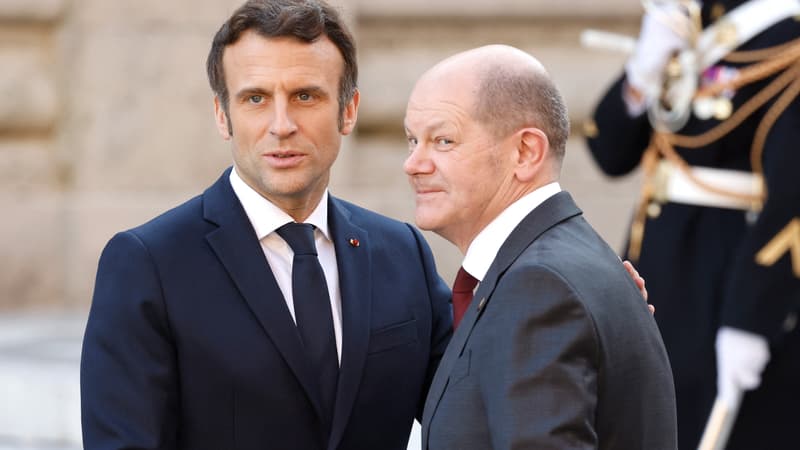Will the war in Ukraine have consequences for the weapons programs launched by France and Germany? The two countries are working together on the Scaf (air combat system of the future), the tank of the future MGCS (Main Ground Combat System) and the modernization of the Tiger helicopter to the MkIII standard.
These three programs remain on. If the two countries appear ready to combine their means, the manufacturers in question are stalling to defend their technologies and their markets.
Feedback from the war in Ukraine also had an impact. Will these planned programs be completed from 2035, or even 2040, in case of urgent needs for armaments, and therefore financing, immediately ready for combat?
The Scaf, the plane of the future, ready to take off
For the aircraft of the future, the project is on the right track. With a budget of 3,200 million euros divided between France, Germany and Spain, this program aims to replace the French Rafale and the German and Spanish Eurofighters by 2040.
The three partner states (France, Spain, Germany) have published a budget for phase 1B which should lead to the presentation of a demonstrator in 2029. After long months of very tense discussions, the two manufacturers at the heart of the program (Dassault and Airbus) have recently reached an agreement for the division of tasks. The official launch of the industrial phase will begin on March 20 with 2,000 technicians in Europe, including 800 at Airbus.
The agreement is so promising in terms of air defense modernization, European sovereignty and, no doubt, derived economic benefits, that other EU countries could join Scaf. With other countries, this program valued at a total of 100,000 million euros to lighten the bill of the partner countries.
The return of the Belgians
During a hearing in the Senate, Sébastien LecornuMinister of the Armed Forces supported the expansion of cooperation within Europe.
On January 24, during a press conference, Admiral Michel Hofman, head of the Belgian Defense, said that he was in favor of entering the Scaf program.
According to the Belgian press, this project would have the support of the Belgian Defense Minister, Ludivine Dedonder, who “wants to put everything in motion so that Belgium and its companies take their place on board the program.”
The tank of the future MGCS facing the “plans B”
The tank of the future MGCS (Main Ground Combat System) that will replace the German Leopard 2 and the French Leclerc tank from 2040 is also on the right track. Well almost.
On paper, the program is progressing. Last November, after months of blockade that suggested the abandonment of the project started in 2017, the French and German industrialists Nexter and Rheinmetall reached an agreement on the division of tasks.
While waiting for the MGCS, France is modernizing its Leclerc tanks to make them compatible with the Scorpion program for collaborative combat. But for the Minister of the Armed Forces, this update “cannot take us many decades, we will need to have a solution in this segment”. It is based on the MGCS program which seems much more urgent than the Scaf.
Rheinmetall’s plan B
For its part, Rheinmetall has already launched a plan B. Starting in 2022, at the Eurosatory fair, the manufacturer unveiled the KF-51 Panther developed with its own funds. This ultra-modern tank appears as a possible successor to the Leopard 2, a role assigned to the MGCS.
The manufacturer even says that it is ready to deliver the first Panthers in 2025.
This project has not been approved by Berlin, which must agree to sell arms abroad. Nothing is done, but the concern is real about the Franco-German program as expressed by Senator Cédric Perrin on February 28 during the audience of the Minister of the Armed Forces.
The Minister is referring to Krauss-Maffei Wegmann (KMW), Nexter’s partner in the MGCS program for which they created the KNDS joint venture. In response to Rheinmetall’s Plan B, KNDS presented its own: the EMBT (Euro Main Battle Tank) created from a Leopard 2A7 chassis and a Leclerc turret.
Helicopter: the Tiger MkIII, out of date ahead of time?
The case of the Tiger MkIII is the most fragile program. It is a modernization of the Tiger to adapt it to collaborative combat and extend it until 2050. This ambitious project from the financial and technological point of view was initially launched between France, Germany and Spain. Just a year ago, Berlin decided not to modernize its 53 Tigers and perhaps replace them with Boeing’s American Apaches. Berlin has submitted a Request for Information (RFI).
Therefore, Paris and Madrid must share the program of 4,000 million euros: 2,800 million euros for 42 French helicopters and 1,200 million for the 18 Spanish helicopters. France has 67 aircraft, but the lack of Berlin’s participation in the program generates additional costs that only allow the modernization of part of the fleet. The remaining 25 aircraft “will be modernized later, but they will be,” the Ministry of the Armed Forces confirmed to us at the time. This budget would be around 1,500 million euros.
But on February 28, during a Senate hearing, the Minister of the Armed Forces was less optimistic about the program, both technologically and financially.
It raises the “drone question” by asking if “won’t we have an already obsolete super helicopter?” “The question is not mediocre, I suppose to ask it publicly,” adds the minister.
Sébastien Lecornu also raises the “economic sustainability” of the program. “If the helicopter is great but you can only buy a few and you’ll have a hard time exporting it, that’s a hardship.
To decide on the issue, the Minister instructed the Armed Forces and the DGA together with the manufacturers to update the program or make it evolve. “It’s not bad news, it’s just good news that needs to be adapted.”
Source: BFM TV


